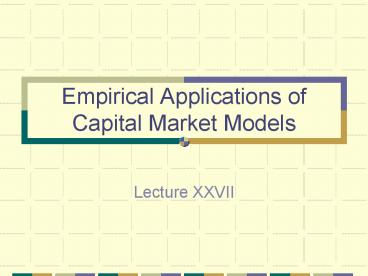Empirical Applications of Capital Market Models - PowerPoint PPT Presentation
1 / 26
Title:
Empirical Applications of Capital Market Models
Description:
Black's Model ... Which yields the empirical model. Black's Results (0.23618) (0.11667) (0. ... Black. Sharpe-Lintner. Tests for CAPM Efficiency. Sharpe-Lintner Model. Cross ... – PowerPoint PPT presentation
Number of Views:115
Avg rating:3.0/5.0
Title: Empirical Applications of Capital Market Models
1
Empirical Applications of Capital Market Models
- Lecture XXVII
2
Capital Asset Pricing Models
- A basic question that must be addressed in the
application of both CAPM and APT models is
whether a risk-free asset exists.
3
- In the basic Sharpe-Lintner CAPM model
4
(No Transcript)
5
- Constructing a dataset of 43 stocks from the
Center for Research into Security Prices (CRSP)
dataset, using the return on the Standard and
Poors 500 portfolio and using the 3 month
treasury bill as the market portfolio
6
Sharpe-Lintner Results
7
Blacks Model
- An alternative to the model presented by Sharpe
and Lintner is the zero-beta model suggested by
Black - where R0m is the return on the zero-beta
portfolio, or the minimum variance portfolio that
is uncorrelated with the market portfolio
8
- However, the model can be estimated assuming that
the zero-beta return is unobserved as - Which yields the empirical model
9
Blacks Results
10
Comparison of Betas
11
Tests for CAPM Efficiency
- Sharpe-Lintner Model
12
(No Transcript)
13
Cross-Sectional Regression
- Fama, E. and J. MacBeth Risk, Return, and
Equilibrium Empirical Tests. 71(1973) 60736. - Using either set of betas, the question then
becomes whether the expected returns are
consistent with their betas.
14
Cross-Sectional Results
15
- Two Tests
- Sharpe-Lintner test of the constant
- Betas explain the variations in expected returns
16
- A little reformulation
- where Di is a dummy variable which is equal to
one if the stock is an agribusiness stock and
zero otherwise
17
Risk Premium for Agribusinesses
18
Arbitrage Pricing Model
- As we discussed in previous lectures, the returns
in the arbitrage pricing model are assumed to be
determined by a linear factor model
19
- Rt is a vector of N asset returns
- ft is a vector of k common factors
- b is a Nk matrix of factor loadings
- The arbitrage pricing equilibrium implies that
the expected return on the vector of assets is a
linear function of the factor loadings
20
- Two ways to define the common factors
- Endogenously based on returns
- Exogenously based on macroeconomic variables
21
- Given the linear factor model above, the variance
matrix for the returns on the vector of assets
becomes - where ? is a diagonal matrix.
22
- Under this specification, we can estimate the
vector of factor loadings by maximizing
23
Factor Loadings
24
Estimated Risk Premia
25
- Augmenting the model to test for disequilibria in
the equity market for Agribusinesses
26
Estimated Risk Premia































